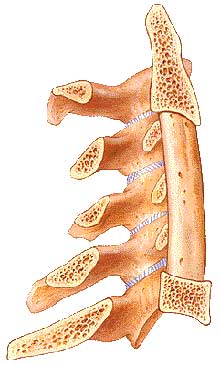Cervical Corpectomy
A Patient's Guide to Cervical Corpectomy
Introduction

Most neck pain is due to degenerative changes that occur in the intervertebral discs of the cervical spine and the joints around between each vertebra. The vast majority of patients who have neck pain will not require any type of operation. However, in some cases degenerative changes in the cervical spine can lead to a very serious condition where there is too much pressure on the spinal cord. When this condition occurs, the entire spinal cord is in danger. One surgical option is to remove the pressure on the spinal cord by removing the degenerative vertebrae and replacing them with a bone graft. This procedure is called a corpectomy and strut graft.
The purpose of this information is to help you understand:
- The anatomy of the cervical spine
- The rationale for performing a corpectomy and strut graft
- What you can expect from this procedure, including possible complications
Anatomy
In order to understand your symptoms and treatment options, you should start with some understanding of the general anatomy of your neck. This includes becoming familiar with the various parts that make up the neck and how these parts work together.
If you have not already done so, please review the document, entitled:
Rationale
If spinal stenosis is the main cause of your neck pain, then the spinal canal must be made larger and any bone spurs pressing on the nerves must be removed. One way that this is done is with a corpectomy. Corpectomy means "remove the body" (in this case the body of the vertebra).
Once the vertebral body (or bodies) has been removed, a cervical fusion is performed. Because the vertebral body has been removed, it means that the surgeon must fill the space left a block of bone taken from the pelvis or a from one of the leg bones. Placing a bone graft in the empty space holds the remaining vertebrae apart. As the bone graft heals it causes the vertebrae to grow together, or fuse.
A cervical spine fusion is done for two reasons:
- To remove pressure on the spinal cord caused by bone spurs
- To stop the abnormal motion between vertebrae
The Operation
An effective procedure for removing the pressure on the spinal cord causing spinal stenosis and cervical myelopathy is to remove the vertebrae that are putting pressure on the front of the spinal canal. This means that the largest part of several of the vertebra must be removed - the vertebral bodies and the discs between each vertebra.
In the cervical spine, the vertebrae and the discs are usually removed from the front. An incision is made in the front of your neck right beside your trachea (windpipe). The muscles are moved to the side. The arteries and nerves in the neck are protected as well.
Once the spine is reached from the front, each disc and vertebra are identified using an X-ray to make sure that the right vertebrae and discs are being removed. Once this is determined, the vertebrae and discs are removed all the way back to the spinal cord. Any bone spurs that are found sticking off the back of the vertebra are removed as well. Great care is taken to not damage the spinal cord and nerve roots.
This procedure is called a corpectomy. "Corpus" means body and "ectomy" means remove. Once the problem-causing vertebral bodies have been removed, the space must be filled with something. This space is usually filled with a structural bone graft. A strut graft can either be an "autograft" that is taken from the small bone in your leg, or it can be an allograft, which is bone taken from someone else.
For a complete understanding of bone grafting, you may wish to review the document, entitled:
Some type of internal fixation is usually required to hold the vertebra and the bone graft in place. This is usually done by placing a metal plate on the front of the cervical spine and attaching the plate to both the remaining vertebrae and the strut graft with metal screws.
You will probably also need to be placed in a halo jacket to hold your head perfectly still while the healing occurs and the vertebrae fuse. You should be aware that this is a very uncommon procedure.
For a complete understanding of different types of spine braces and to understand what a "halo jacket" is, you may wish to review the document, entitled:
Rehabilitation
This is a serious operation. You will probably be restricted to minimal activity during the early healing phases following the surgery. If you are in a halo jacket, you will not be able to do much rehabilitation. However, you should work to keep your arm and leg strength intact. A physical therapist will be contacted to help you with an exercise routine.
Once the fusion is healed, you may progress on to a more vigorous rehabilitation program.
For a more complete discussion of the rehabilitation programs for neck problems refer to the separate document, entitled:
Complications
With any surgery, there is a risk of complications. When surgery is done near the spine and spinal cord these complications (if they occur) can be very serious. Complications could involve subsequent pain and impairment and the need for additional surgery. You should discuss the complications associated with surgery with your doctor before surgery. The list of complications provided here is not intended to be a complete list of complications and is not a substitute for discussing the risks of surgery with your doctor. Only your doctor can evaluate your condition and inform you of the risks of any medical treatment he or she may recommend.
To understand more about the potential complications of spinal surgery please review the document, entitled:
Copyright © 2003 DePuy Acromed.
